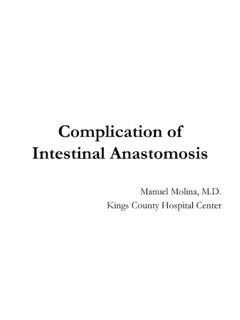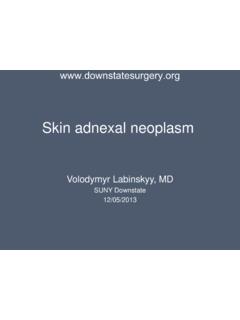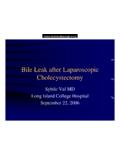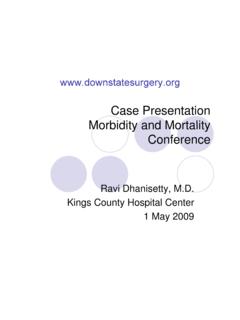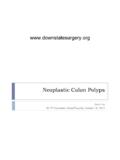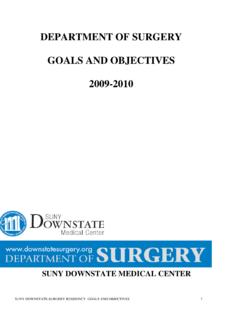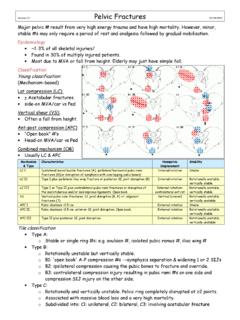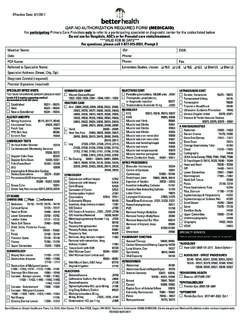Transcription of MISSED URETERAL INJURIES MANAGEMENT
1 MISSED URETERAL MISSED URETERAL INJURIES MANAGEMENTINJURIES MANAGEMENTC orneliuCorneliuT. T. VulpeVulpe, , County HospitalKings County HospitalJuly, 2004 July, 2004 URETERAL INJURIESURETERAL INJURIESLATE MANAGEMENTLATE MANAGEMENTI nitial EvaluationInitial Evaluation Fewer than 1% of all GU injuriesFewer than 1% of all GU INJURIES Causes: Causes: --penetrating trauma (GSW penetrating trauma (GSW --most most common, followed by SW)common, followed by SW)--deceleration deceleration avulsion of avulsion of ureterureterat at UPJ, more common in childrenUPJ, more common in children HematuriaHematuria: gross or microscopic : gross or microscopic only 30only 30--70%70%PrestiPrestiJC, Carroll PR, JC, Carroll PR, McAninchMcAninchJW: J Trauma 29:370, 1989 JW: J Trauma 29.
2 370, 1989 Boone TB, Boone TB, GillingGillingPJ, PJ, HusmannHusmannDA: J DA: J UrolUrol150:33, 1993150:33, 1993 BrandesBrandesSB, SB, ChelskyChelskyMJ, MJ, BuckmanBuckmanRF, et al: J Trauma 36:766, 1994RF, et al: J Trauma 36:766, 1994 DiagnosisDiagnosis CT with delayed cutsCT with delayed cuts IV IV urographyurography LaparotomyLaparotomy: : hematomahematomanear kidney or near kidney or ureterureter1. on1. on--table IVP table IVP if not diagnostic:if not diagnostic:2. direct inspection: injury, contusion, peristalsis2. direct inspection: injury, contusion, peristalsis3. indigo3. indigo--carmine injection into collecting systemcarmine injection into collecting systemManagementManagement All INJURIES to the All INJURIES to the ureteruretershould be repaired should be repaired surgically, unless a delay in diagnosis results in surgically, unless a delay in diagnosis results in an abscess or a an abscess or a urinomaurinoma For either abscess or For either abscess or urinomaurinoma, drainage by , drainage by percutaneouspercutaneousnephrostomynephr ostomyand and ureteralureteralstentingstentingmay allow the inflamed may allow the inflamed ureterureterto heal, whereas to heal.
3 Whereas an operative approach may result in an operative approach may result in nephrectomynephrectomyOperative ManagementOperative MANAGEMENT debridementdebridementof devitalized tissue (GSW more than SW)of devitalized tissue (GSW more than SW) mobilization of the mobilization of the ureteruretershould be limited to avoid should be limited to avoid compromising the blood supplycompromising the blood supply tensiontension--free free anastomosisanastomosis, watertight mucosal , watertight mucosal approximation (interrupted 5approximation (interrupted 5--0 or 60 or 6--0 0 VicrylVicrylpreferred)preferred) ureteralureteralstentingstenting(double J (double J stentstentor a or a nephrostomynephrostomytube) tube) coverage of the repair with coverage of the repair with vascularizedvascularizedtissuetissue drainagedrainage partial partial transectionstransectionsmay be closed primarilymay be closed primarilySpecial considerationsSpecial considerationsTransureteroureterostomyTr ansureteroureterostomy--for large defects in the abdominal for large defects in the abdominal ureterureter--the injured the injured ureterureteris passed behind the is passed behind the mesocolonmesocolonto the to the contralateralcontralateralside, side.
4 Anastomosedanastomosedto a 1 to a 1 --2 cm opening in the 2 cm opening in the medial normal medial normal ureterureterover a 5 Fr over a 5 Fr stentstentUreterocystostomyUreterocystos tomy--injury below the pelvic brim injury below the pelvic brim --the distal stump is the distal stump is ligatedligated, and after the anterior bladder wall is , and after the anterior bladder wall is opened, the proximal end of the opened, the proximal end of the ureterureteris brought through a new is brought through a new hiatus on the back wall of the bladder Large defects can be hiatus on the back wall of the bladder Large defects can be bridged by performing a bridged by performing a vesicovesico--psoaspsoashitch. Significant bladder hitch.
5 Significant bladder or vascular damage may require or vascular damage may require transureteroureterostomytransureterouret erostomy. A . A ureteralureteralstentstentshould be used in all should be used in all ureteralureteralreimplantationsreimplant ations. The . The bladder is closed in two layers with a continuous 2bladder is closed in two layers with a continuous 2--0 0 VicrylVicrylsuture, and a drain is placed in the suture, and a drain is placed in the CarePostoperative Care Retroperitoneal drains Retroperitoneal drains D/C once the output is D/C once the output is minimalminimal CT or IVP before D/C from the hospital to CT or IVP before D/C from the hospital to r/or/oextravasationextravasation Bladder catheterization Bladder catheterization --7 days after 7 days after ureteralureteralreimplantationreimplanta tion(in combined bladder and (in combined bladder and ureteralureteralreconstructions, contrast reconstructions.))
6 Contrast cystographycystographyis indicated is indicated before catheter removal)before catheter removal) CystoscopicCystoscopicremoval of the double J removal of the double J stentstentunder local under local anesthesia 4 to 6 weeks after operationanesthesia 4 to 6 weeks after operation Intravenous Intravenous urographyurography3 months after removal of the 3 months after removal of the stentstentto to r/or/oasymptomatic obstruction asymptomatic obstruction ComplicationsComplications FistulaFistula--result of distal obstruction or necrosis of the result of distal obstruction or necrosis of the ureterureter(managed by (managed by antegradeantegradeor retrograde drainage of or retrograde drainage of the collecting system using the collecting system using percutaneouspercutaneousor or endoscopicendoscopictechniques and
7 Drainage of techniques and drainage of periureteralperiureteralcollection) If collection) If recognition of an injury or complication is delayed, recognition of an injury or complication is delayed, reconstruction should not be undertaken for at least 3 reconstruction should not be undertaken for at least 3 months, to allow resolution of the inflammatory phase months, to allow resolution of the inflammatory phase of wound healingof wound healing HydronephrosisHydronephrosis--result of stricture, retroperitoneal result of stricture, retroperitoneal fibrosis, or a fibrosis, or a urinomaurinoma, repeat imaging is appropriate 1 , repeat imaging is appropriate 1 year after injury year after injury Delayed RecognitionDelayed Recognition recognized recognized intraoperativelyintraoperativelyin approximately 34% in approximately 34% delayed diagnosis is most often (66% to 76%) made by CT delayed diagnosis is most often (66% to 76%) made by CT pyelographypyelography, , excretory excretory urographyurography, or retrograde , or retrograde ureterographyureterography signs and symptoms: report of 35 patientssigns and symptoms.
8 Report of 35 patientsanuriaanuria5 (most with bilateral injury)5 (most with bilateral injury)urogenitalurogenitalfistulafistul a44persistent pain/fever persistent pain/fever 33urinary leakage from the wound 3urinary leakage from the wound 3hydronephrosishydronephrosis11hematuria hematuria1 1 ((GhaliGhaliet al et al --J Trauma 1999;46:150J Trauma 1999;46:150 158)158) triad of fever, triad of fever, leukocytosisleukocytosis, and generalized peritoneal signs , and generalized peritoneal signs (Medina et al (Medina et al --J Am J Am CollCollSurgSurg1998;186:6411998;186:641 644).644).TreatmentTreatment immediate attempt at placement of a doubleimmediate attempt at placement of a double--J J ureteralureteralstentstent--possible in only 20% to 50% possible in only 20% to 50% --failure to place a failure to place a stentstentis due to complete obstruction is due to complete obstruction of the of the ureterureteror to a gap too long to bridge or to a gap too long to bridge ((CormioCormioet al et al --Br J Br J UrolUrol1993;72:1651993;72:165 168)168)((GhaliGhaliet al, 1999et al, 1999--J Trauma 1999;46:150J Trauma 1999.))
9 46:150 158 )158 )--success rate as high as 73% without the need for open success rate as high as 73% without the need for open surgery surgery (Dowling et al J (Dowling et al J UrolUrol1986;135:9121986;135:912 915)915)TreatmentTreatment open repair as soon as possible, but the delay in diagnosis open repair as soon as possible, but the delay in diagnosis increases the complication rate from 10% to 40% increases the complication rate from 10% to 40% (Campbell et al (Campbell et al --Urology 1992;40:216 Urology 1992;40:216 220).220). If If stentstentplacement is achieved, open repair is required only in placement is achieved, open repair is required only in those patients with persistent leakage or those patients with persistent leakage or ureteralureteralstricturestricture(Dowli ng et al J (Dowling et al J UrolUrol1986;135:9121986;135:912 915)915) 100% success rate in treating late 100% success rate in treating late ureteralureteralcomplications with a complications with a ureteralureteralstentstentfor 3 months for 3 months (Cormio et al (Cormio et al --Br J Br J UrolUrol1993;72:1651993.
10 72:165 168)168) The optimal duration of The optimal duration of stentingstentingrecommended at least 6 weeksrecommended at least 6 weeks((SelzmanSelzmanAA, AA, SpirnakSpirnakJP JP --J J UrolUrol1996;155:8781996;155:878 881)881)TreatmentTreatment NephrostomyNephrostomytube and tube and antegradeantegradestentingstentingin patients in patients that fail placement of a retrograde that fail placement of a retrograde ureteralureteralstentstent(wait 7 (wait 7 to 14 days to reattempt to 14 days to reattempt antegradeantegradestentingstentingif this fails)if this fails) UreteralUreteralballoon catheters, which stop urine from balloon catheters, which stop urine from traveling down the traveling down the ureterureter, may be required if simple , may be required if simple stentingstentingdoes not eliminate associated leakage or does not eliminate associated leakage or urinomaurinoma If the If the ureterureterultimately cannot be ultimately cannot be stentedstented--open repair open repair after waiting several months for complete wound after waiting several months for complete wound healinghealing(Campbell's Urology, 8th ed.

